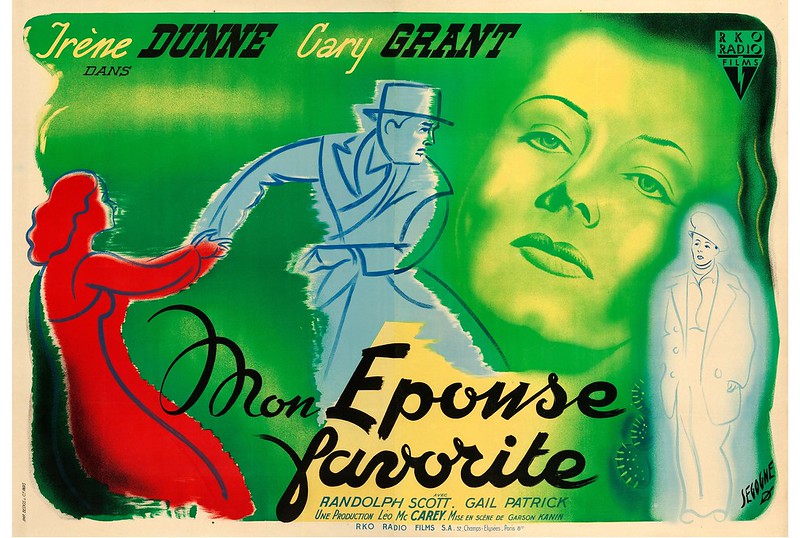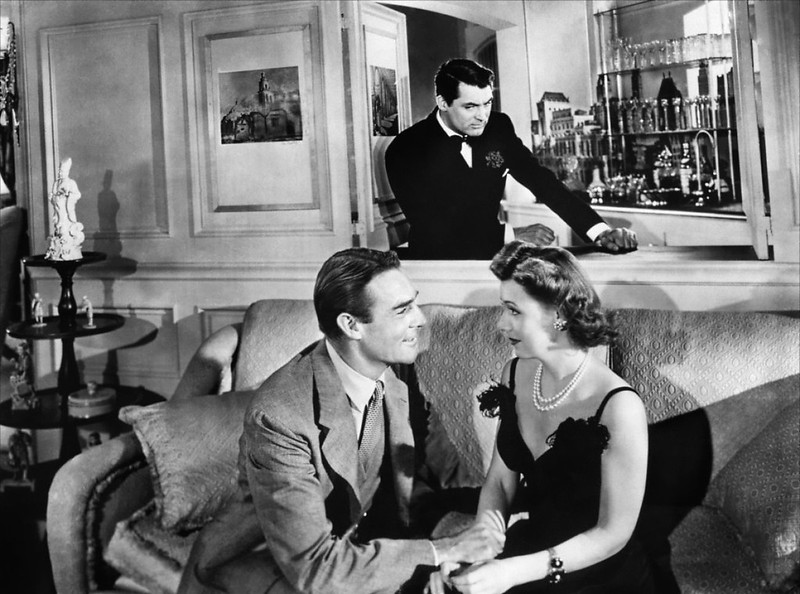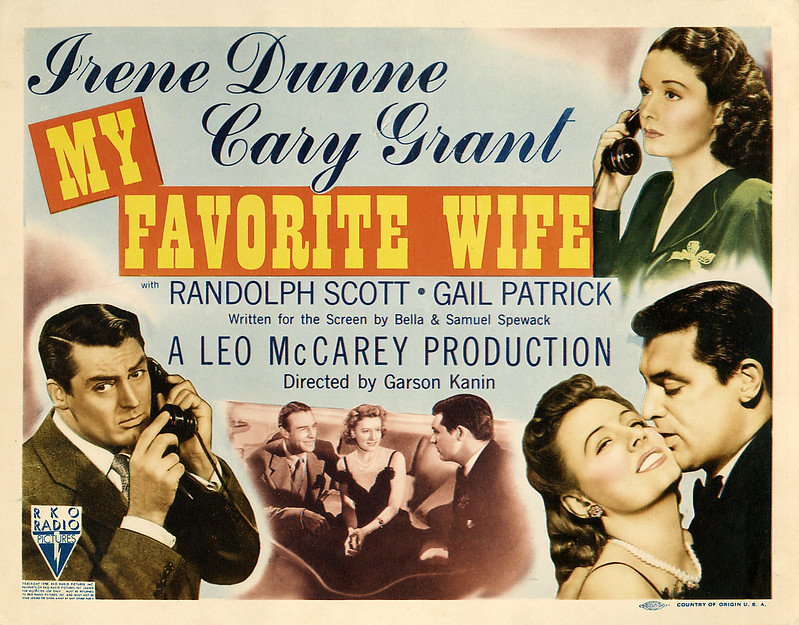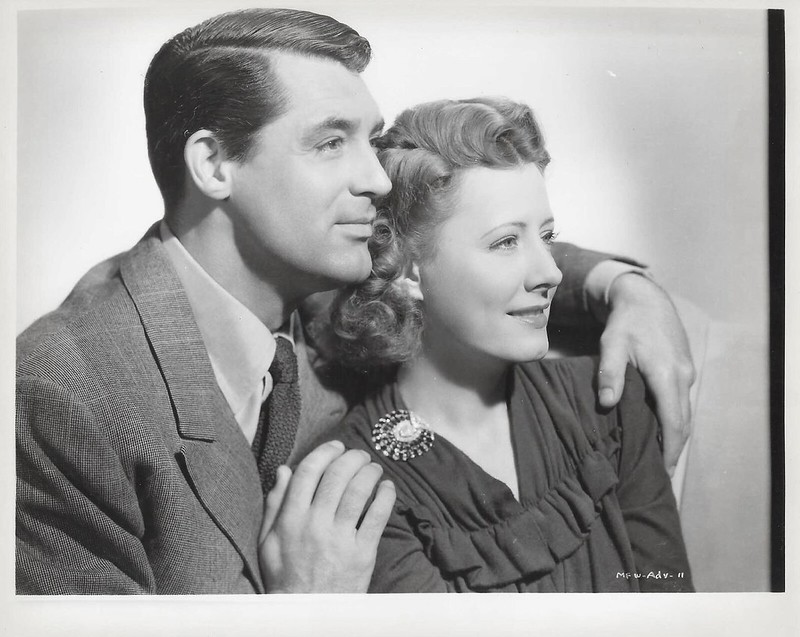The following is my transcript from tonight’s presentation on My Favorite Wife at the Park Ridge Public Library. Nearly 30 patrons came out to see this audience favorite… ~MCH
My Favorite Wife from 1940 is certainly one of my favorite films in this series. Starring Irene Dunne and Cary Grant, the film is a follow-up to their successful 1937 teaming, The Awful Truth, which won that film’s director, Leo McCarey, an Academy Award. My Favorite Wife was to have also been directed by McCarey, but a near-fatal automobile accident prevented him from being on set. Garson Kanin replaced him. Despite the loss of McCarey as the director, he still produced the film and contributed to the screenplay.
The story was inspired by Enoch Arden, the 1864 Alfred Lord Tennyson poem in which a fisherman, thought to be lost at sea, returns home to discover his wife has remarried. There had been earlier film versions of the Tennyson story, notably a 1911 version directed by D. W. Griffith. In My Favorite Wife, it’s the wife who has disappeared– in this case, Ellen Arden, played by Irene Dunne. Cary Grant is Nick Arden, the husband who has recently remarried. His surname is, of course, an homage to the source material. But just as Nick leaves with his new bride (played by Gail Patrick), Ellen shows up at the family home and reveals herself to her mother-in-law. She then takes off by plane in the hopes of catching Nick before his honeymoon night. Complications understandably ensue in this farce, principally due to the fact that characters never tell one another the whole story. They try to but only keep delaying it!
The Enoch Arden premise was transcribed to the screen by the husband and wife writing team of Samuel and Bella Spewack. Leo McCarey, as noted, also contributed as did the film’s replacement director, Garson Kanin. My Favorite Wife was Kanin’s sixth film at the helm. The previous year he had directed John Barrymore in his last really memorable performance in The Great Man Votes. Later in the 1940s, Kanin would write the screenplay for A Double Life, which won Ronald Colman his Academy Award for Best Actor.
French poster of My Favorite Wife.

My Favorite Wife would be nominated for an Academy Award for Best Story. Despite the laughs inherent in the script, the actors found it difficult to be funny on the set. As actress Gail Patrick remembered, “On My Favorite Wife we were desperately trying to be funny as our producer, Leo McCarey, lay at death’s door from an automobile crash. He recovered, but I never thought we entered into the spirit of that one. We couldn’t—we were waiting for bulletins from the hospital.” A few weeks into the shooting, however, McCarey recovered sufficiently enough to visit the set. McCarey later told author Peter Bogdanovich that after the car accident, he had been taken to the hospital in a hearse because an ambulance wasn’t available.
The fourth member of the quartet of stars is Randolph Scott—the man who was on Ellen’s deserted island and who plans to court her in the wake of Nick’s remarriage. Scott often played heroic leading men, but his greatest claim to fame would be as a Western star, particularly in those films made by Budd Boetticher in the 1950s. Scott was a close friend of Grant’s with the two men sharing an apartment together off and on over the years. A whole narrative has been spun by modern “historians” on their relationship. This is all based on candid photos which, in the eyes of some, reveal a sneak peek into an intimate relationship. The truth, according to Randolph Scott’s son, Chris, is that these photos were all carefully staged by a Paramount publicist who may or may not have had an agenda. This material was designed for the fan magazines and was intended to show the bachelor life between Scott and Grant. In My Favorite Wife, Grant may have even been poking fun at all this in the scene at the Pacific Club in which he starts wiping his brow at the sight of the manly Randolph Scott diving into the pool.
As with the other films in this series, there are some outstanding character actors at work, like Donald MacBride, who plays the hotel clerk wary of a scandal after seeing Grant visiting with both his wives. Another actor worth mentioning is not as recognizable but he appeared in over 90 films, and that’s Granville Bates as the crotchety judge who has Ellen declared legally dead at the start of the film. Bates was born in Chicago and is buried at Graceland Cemetery.
In fact, Bates’ character made such an impression, his role was expanded. Originally, when My Favorite Wife was previewed, the film had problems; it just wasn’t as funny after about an hour. McCarey said it was because “it was a lot of unraveling of a tricky plot.” McCarey was editing the film himself after the cast and crew had been dismissed. He didn’t know what he could do to save the film until he had a revelation. “Then I got the wildest idea I ever had,” McCarey said. “There was a judge in the opening who was very funny, and he dropped out of the picture, and I decided to bring him back. What we actually did was to tell the judge our story problems in the picture and have him comment on them. And it was truly great. It became the outstanding thing in the picture.”
McCarey and Kanin worked on the judge’s dialogue with the assistance of actress Gail Patrick, who had been a law student at the University of Alabama and knew the terminology. Reportedly, these changes led to some fights with writer Bella Spewack, whose work they had to toss. A couple sequences were removed and a new reel was added. When the film was previewed again, the audience reaction went considerably better. The film became a huge hit for RKO—the second-highest grossing film for the studio that year behind Kitty Foyle, which starred Ginger Rogers.
This scene appears on the lobby card but not in the film. This is most likely part of the scenes cut out by McCarey during his editing room revelation.

Though the Grant and Dunne teamings aren’t remembered quite in the same way as the Katharine Hepburn and Spencer Tracy films, for instance, the two nevertheless had great chemistry. In fact, it was on the basis of their popularity in The Awful Truth that Leo McCarey was able to sign them up for a second movie together– before there was ever a script. After My Favorite Wife, Irene Dunne and Cary Grant starred in the 1941 melodrama Penny Serenade, which was directed by George Stevens.
But their finest work remains The Awful Truth, and My Favorite Wife does harken back to that earlier film, particularly in two sequences. The first is the scene in which Ellen plays a guest in her own home and affects a Southern accent. With the new bride present, Ellen pretends to be an old childhood friend. The scene recalls the one in The Awful Truth in which Dunne tries to embarrass Grant at his family home with her outrageous behavior as his “sister”– all done in the hope of winning him back. Secondly, though the circumstances are different, the final scene, in which Nick plans a return to his wife’s bed, recalls the waiting game in The Awful Truth.
Coincidentally, 1940 also saw the release of Too Many Husbands starring Jean Arthur, yet another variation of the Enoch Arden story. My Favorite Wife was the inspiration for the ill-fated Something’s Got to Give in 1962, which was to star Marilyn Monroe, Dean Martin and Cyd Charisse. Monroe was fired from the production and later died that summer, so that version was never completed. In 1963, there was a remake with Doris Day and James Garner called Move Over, Darling.


